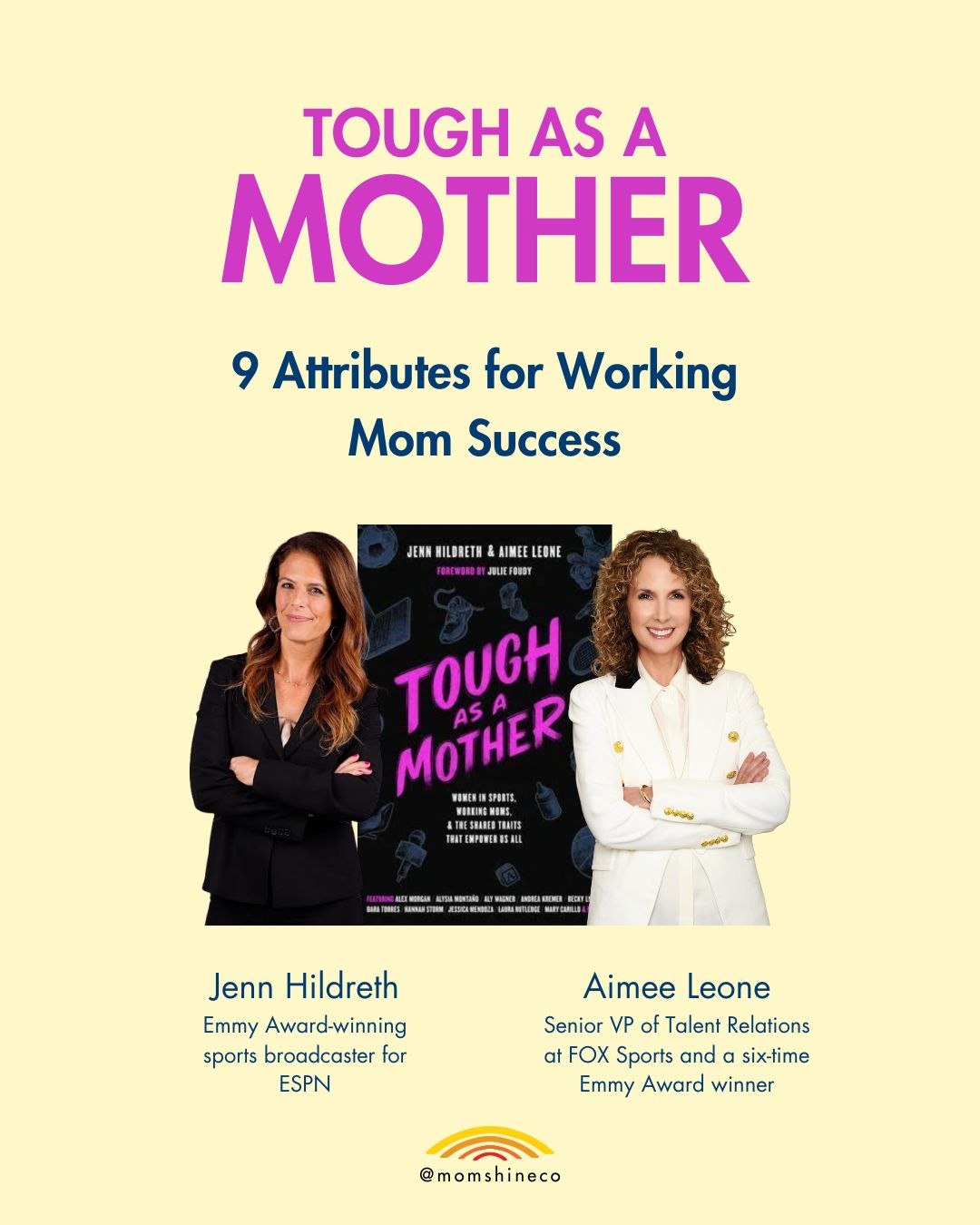The Bloopers That Built Me: 11 “Mistakes” That Made Me a Better Mom
Three summers ago, I left the workforce with a big smile and no idea what was coming. I thought I’d traded startup chaos for the “freedom” of working for myself—then learned building your own thing can be just as consuming. The little tasks I used to avoid (laundry, housecleaning, meal prep) suddenly moved to the top of my list.
Two years into MomShine, I see it clearly: the mom “mistakes,” the myths I believed, and the messy detours weren’t failures—they were the path. Motherhood has felt like growing up all over again: a crash course in humility, resilience, and rediscovering myself. If I’ve learned anything, it’s that meaning lives inside the mess. Every detour, meltdown, and “oops” helped shape who I am today.
Motherhood asks us to shape-shift and shine—to do what makes us our best selves, because that’s the best gift we can give our kids. Turning failures into fuel is where the real learning happens.
So, here are the bloopers that built the blueprint.
Mom Mistake 1: Thinking There Was a Playbook (Instead: Embrace Motherhood’s Chaos)
I thought I could plan my way through motherhood. Instead, I learned that chaos is the playbook. Flexibility and humor—not control—get you through. And every kid is different. What worked for one might not for another. It’s all about adapting and pivoting for the best outcomes.
Try this: Set a weekly “what worked/what didn’t” family huddle (10 minutes).
Mom Mistake 2: Thinking Working for Myself Would Mean Less Guilt
I believed entrepreneurship would give me freedom from mom guilt. But guilt didn’t disappear—it just changed shape. What I’ve learned: presence matters more than perfection. And whether you work, work from home, or have flexible work arrangements, you will constantly ask if you are doing enough. The truth is, you are, and then some, just by being there.
Mom Mistake 3: Thinking Success Was About Hustling Harder
Burnout taught me that hustle ≠ happiness. Success is a mindset shift for moms, especially, not more hours of grinding. I recently interviewed Lisa M Easton, who mentioned that the key to success is all in shifting your mindset. Our episode on Manifesting Your Future is less about working more. She manifests her goals in scripted, tangible formats, and within 3 months, the goals she manifests begin to come to reality. Because when you believe what’s possible, things start to shift.
Mom Mistake 4: Thinking Kids Needed a Ton of Activities
We overscheduled, we burned out, and we even dealt with blown growth plates. Now I believe one activity per season (with lots of downtime) can be more than enough. Too many activities can lead to overscheduled kids burning out. And simple conditioning, stretching, and any other passions can aid in a long-term active lifestyle.
Check out our article, "7 Time Management Questions on Kids’ Activities Answered," for more clarity. I also refer to the chart of age-appropriate learning for sports frequently.
Mom Mistake 5: Assuming It Would Get Easier
Spoiler: it doesn’t. Each stage is hard—and beautiful—in its own way. Motherhood is all-in, always. Shifting expectations is how you find energy. As they get older, needs start to shift, but there is no easy parenting as it evolves and at times gets even more complex.
One thing I’m loving as my tween starts making her way is staying up to date on their new lingo and teen slang, if you will! [I covered this in this article and will compile a new one for this year.] This helps me connect, defuse conflict, and get a good laugh from time to time.
Fun win: Learn their slang—it’s connection (and comic relief).
Mom Mistake 6: Treating AI + Social Like the Enemy
Instead of fearing tech, I’ve started teaching my kids to harness it as a tool—and modeling curiosity instead of avoidance. I don’t know about you, but tech and kids are so overplayed in the media as clickbait and around fear. When I had Tina Sharkey, a leader in AI, she said it’s all about teaching kids discernment in today’s modern world. Leverage it as a tool for them to be curious instead of thinking it’s the end-all, be-all to their reality. Additionally, AI and parenting complement each other nicely, simplifying tasks such as packing lists, dinner planning, and more.
I’ve also realized there’s no shame in digging in and finding shortcuts where you can. Two-in-one products, supporting female-founded brands, or leaning on AI for help with stories, chore charts, or even travel planning — these little hacks free up more space for what actually matters.
Some AI posts for busy moms for more inspo on this topic:
- 10 AI Wins That Actually Work for Busy Moms
- Rome with Kids: 3 AI Travel Hacks for a Smoother Family Trip
- Top AI Hacks for Busy Moms: 6 Genius Ways to Simplify Life
Mom Mistake 7: Thinking I Was in Menopause
Marketing had me convinced my body was broken. In reality? It was undiagnosed endometriosis. Lesson: advocate for yourself. I had to become well-versed on endometriosis awareness and am now educating my girls. If something feels wrong, get answers. Again, marketing can catch us all, and it could be why menopause is having a moment, but listen to your own body first.
Mom Mistake 8: Thinking I Had to Do It All Myself
Delegation is love. Ask for help, accept it, and redistribute the load at home. I wore “doing it all” like a badge of honor. But trying to be the cook, chauffeur, nurse, therapist, and CEO of the house left me drained. Asking for help (and accepting it) doesn’t make you less of a mom—it makes you a human one.
Mom Mistake 9: Thinking Self-Care Was Selfish
For years, I put myself last. The result? Burnout and resentment. I’ve since learned that when I fill my tank—through movement, rest, or joy—my whole family benefits. Time away and self-care aren’t indulgent; they’re family care.
Mom Mistake 10: Thinking Daily Intentional Habits Wouldn’t Change Much
Consistency changes everything. I used to believe that setting goals, meditating, and exercising daily were “nice-to-haves,” not life-changers. But when I made them non-negotiable, my world shifted. Within two months, I landed a job I’m thrilled about — and that role found me while I was finally clear on the goals I was striving toward. Manifesting, as my podcast guest Lisa M. Easton taught me, is more than wishful thinking. It’s a daily, intentional practice of scripting your success that rewires your belief in what’s possible. And now, I’ll never look back.
Making those habits non-negotiable was my way of protecting my shine. The clarity I gained permeated every aspect of my life, and it serves as a reminder that being your best self is the most powerful example you can set for your kids.
Mom Mistake 11: Thinking “Good Moms Don’t Get Angry” or Also Have Meltdowns
Suppressing emotions leads to explosions. Lesson: kids benefit from seeing healthy expressions of all emotions—anger included—and how to repair after conflict. Be yourself! Highs, lows, and everything in between as you evolve with your kids.
Mom Takeaways = Turning the Imperfections Into Mom Wins!
Motherhood isn’t about avoiding mistakes—it’s about growing through them. Every ER visit, tear-filled night, and moment of doubt carved me into a more present mom and human. I’m bringing these lessons with me as I return to full-time work—and I hope they remind you to shape-shift where you need to, find your shortcuts, and protect your shine. It does work out. It always does.
Want more real talk? Listen to the MomShine Podcast or message me for free planning templates that work (Away Doc, Chore Biz, Feelings Chart) and make the day-to-day a little lighter!
8 Ways Lisa M. Easton is Helping Moms Build Wealth Without Burnout
On Episode 327 of the MomShine Podcast, I sat down with Lisa M. Easton—speaker, author, coach, and self-made millionaire—to talk about something that often feels out of reach for moms: wealth. Not just financial wealth, but freedom, fulfillment, and a life where we’re not constantly running on empty.
Lisa has supported high-net-worth individuals, studied the habits of millionaires, and built her own empire. Today, she’s on a mission to show women—especially moms—that success isn’t a secret club. Her perspective flips the script on what it actually takes to live a rich life. Here are six powerful ways she’s helping moms everywhere rethink success.
1. Money Isn’t the End-All for Happiness
One of Lisa’s biggest revelations came while supporting wealthy entrepreneurs. She noticed that many of them—despite the houses, cars, and bank accounts—were deeply unfulfilled. What set the happiest apart wasn’t their net worth, but their foundation in meditation, movement, and mindset work.
Happiness, she reminds us, is built from within, not from the commas in your account.
2. Success Is a Mindset, Not More Hard Work
Lisa’s mantra: “You can’t out-hustle your way into happiness.” Moms already know how to work hard—sometimes too hard. What we need more of is permission to think differently.
Reframing how we view our time, energy, and money shifts everything. Success isn’t about piling on more hours; it’s about aligning your actions with the belief that you’re already worthy of building wealth and joy.
3. Self-Care Is a Wealth Strategy
It might feel indulgent to carve out time for yourself, but Lisa argues the opposite: self-care is the engine that drives how you show up for your family, your work, and your dreams.
“When you don’t pour into yourself, you’re operating from depletion,” she shared. Giving yourself more permission to rest, move, or nourish your body isn’t selfish—it’s a wealth-building mindset.
4. You Don’t Need Your Own Wealth to Make Money
A huge myth Lisa busts: you don’t need to already have wealth to build it. Many entrepreneurs got rich by investing other people’s money—because they believed they were worthy, built trust, and followed through.
Wealth isn’t about starting with a cushion; it’s about believing in your ability to steward resources well, whether they’re your own or entrusted to you.
5. 15 Minutes a Day Can Change Your Life
Lisa encourages moms to set aside just 15 minutes a day for intentional goal setting and visualization. Write down your goals as if they’ve already happened. Script out your future self with 30-40 goals, both generic and detailed, that you want to achieve until they become written into your subconscious. And then watch how the changes start to stack up in as little as three months.
She also swears by micro-practices like:
- Listening to Brian Scott’s Sleep and Grow Rich meditation on success every night (“It’ll change your life,” she says).
- Shri Akarshana’s Manifest UNEXPECTED Money in 48 Hrs or Less to rewire subconscious beliefs.
It doesn’t take hours—it takes consistency.
6. Expand Your Circle, Expand Your Possibilities
We often limit ourselves by the environments we stay in. Lisa believes community and mentorship are non-negotiable for building wealth and fulfillment. Surround yourself with expanders—people who stretch your beliefs about what’s possible.
Even if entrepreneurs do not surround you, you can find community online, in podcasts, or in small daily practices that remind you you’re not alone.
7. Model Generational Wealth for Your Kids
Lisa emphasizes that wealth isn’t just about your bank account—it’s about legacy. She encourages moms to let their kids see them saving, investing, journaling goals, and learning. By modeling healthy money habits and self-belief, you’re planting seeds of generational wealth that go far beyond dollars.
Your children inherit more than your genes—they inherit your mindset.
8. Choose Faith Over Fear
So much of motherhood runs on scarcity thinking: not enough time, not enough energy, not enough money. Lisa flips that script by teaching moms to replace fear with faith.
“Fear shrinks you, faith expands you,” she says. When you make decisions rooted in faith—whether that’s launching a business, asking for help, or investing in yourself—you expand what’s possible, for you and your family.
The MomShine Takeaway
Lisa’s message is clear: success isn’t about chasing perfection, more money, or more hours—it’s about shifting your mindset, caring for yourself, and scripting a life that feels both expansive and free.
If you want to start today, try this: take 15 minutes to journal your goals in the present tense. Let your kids see you saving, investing, and learning. And remember, you don’t have to earn more to start building wealth—you just have to think differently.
You can listen to the full conversation with Lisa M. Easton on MomShine Episode 327 and watch the video version on YouTube.
5 Ways to Avoid Getting Sick This School Year
Back-to-school season is here, and with it comes all the wonderful (and not-so-wonderful) things our kids bring home. My son even asked for $6 to wash his hands — confusing it with getting sick 😂. After a tough tonsillectomy recovery in our house, we’re extra motivated to keep germs at bay this year. And yes, I even braided my daughter's hair to try to dodge the dreaded lice!
Here are 5 doctor-backed ways to help your family stay healthier as we dive into the new school year. These are the habits pediatricians recommend to boost immunity and prevent those common sniffles and bugs.
1. Hand Hygiene Heroes
This is non-negotiable! Frequent and thorough handwashing with soap and water for at least 20 seconds (sing 'Happy Birthday' twice!). Teach kids to wash before eating, after using the bathroom, and as soon as they get home from school. Hand sanitizer is a good backup when soap and water aren't available.
Make it fun: Create a handwashing sticker chart or let your child pick their own silly handwashing song.
2. Prioritize Sleep
A tired body struggles to fight off illness. Aim for consistent bedtimes and sufficient sleep: 9-12 hours for school-aged children and 8-10 hours for teenagers. Sleep is when their immune system recharges!
3. Fuel Up Right
A balanced diet packed with colorful fruits, vegetables, whole grains, and lean proteins provides the essential nutrients for a strong immune system. Don't forget hydration – send those water bottles to school!
Immunity Boosting Grocery List by Color 🌈

✨ Make it fun: Save and print this list for your next store run, stick it on the fridge, and let kids check off colors as they eat them each day — a “rainbow immunity challenge.”
4. Stay Up-to-Date on Vaccinations
Ensure that everyone in the family is up to date on their recommended immunizations, particularly the annual flu shot. Vaccines are a powerful tool in preventing serious illnesses and protecting our communities.
Make it fun: Explain vaccines as 'super shields' that protect their whole team (family, classmates, friends).
5. Practice Smart Germ Etiquette
Teach kids to cough or sneeze into their elbow or a tissue (and dispose of it!). Remind them to avoid touching their face (eyes, nose, mouth) and not to share personal items like water bottles or utensils. And if they're sick, keep them home to prevent spreading germs!
Make it fun: Play 'Germ Ninja' — kids get a point every time they remember to sneeze into their elbow or wash their hands without being asked.
Healthy Habits by Age (Save This!)
Building healthy habits early sets our kids up for life. Here are some age-appropriate focuses:
| Age Group | Focus Areas | Make it Fun! |
| Preschool (3–5) | Handwashing basics, consistent bedtime routine, brushing teeth | Sing while you scrub |
| Elementary (6–10) | Balanced lunches, carrying water bottles, and 1 hour of active play daily | Pack your power lunch |
| Tweens (11–13) | Screen-time limits, hygiene independence, and consistent sleep | Screens down, snooze up |
| Teens (14+) | 8-10 hours of sleep, emotional wellness, stress management, healthy snack choices | Snack swaps = smart fuel |
What I Learned from My Recent Episode with Maimah Karmo
And while these day-to-day habits matter, I was reminded in my recent conversation with the incredible Maimah Karmo (you can watch it here!) that health is also about the long game. One of her biggest takeaways: health is the best legacy we can give our kids.
This means:
- Advocating for early screenings and regular doctor’s visits.
- Becoming an Angel Advocate at the Tigerlily Foundation to own your health journey and educate others.
What’s your go-to trick for keeping germs away? Share your favorite hacks below — because we all need fresh ideas this season!
10 AI Wins That Actually Work for Busy Moms
Between carpool runs, work deadlines, and remembering who has soccer where, mom life can feel like a never-ending blur. Lately, I’ve found an unexpected sidekick: AI. Not just for work emails, but for real-life mom wins that save time, money, and sanity.
Out of the many prompts I’ve tested, here are 10 that actually worked, with my top five favorites called out.
1. Fixing Everyday Annoyances (like the trunk that wouldn’t budge)
That annoying setting in my Suburban that my husband and I couldn’t figure out how to fix? Yeah, AI walked me through the fix in minutes, saving me both time and frustration. We banged our heads one too many times, and silly, it took me so long to realize AI could figure this one out for me just with the make, model, and describing the issue I was having.
2. Turning Recipes Into Kid-Friendly Favorites
From Giada’s pasta to gluten-free swaps to how smoothie flavors might pair, AI has reworked recipes to fit our family’s dietary needs without sacrificing flavor. This has been especially helpful for keeping meals easy, kid-friendly, and delicious all around.
3. Scripts for Meltdowns That Actually Work
I used to have a lot of angst and no idea how to help my son break free from ruts and patterns. Instead of losing patience during meltdowns, I now ask AI for calm, empathetic responses and role play that might help him correct the problem. The phrases it suggested actually worked and helped me manage tough parenting moments with more confidence.
4. Pharmacy Info in a Pinch
When my daughter was at camp, I urgently needed pharmacy details that hadn’t been provided. We had minutes for the doctor’s clearance, and AI quickly pulled the closest CVS near the camp location in seconds. Headed somewhere remote? AI has your back in seconds.
5. New Car Search Help
We are starting to consider a car trade-in, instead of additional work and repairs. AI has become my car-buying copilot—breaking down models, features, and costs so I don’t get overwhelmed. I also want better customer service and not to be left high and dry every time I bring my car into the shop. AI is helping me quickly compare options, along with pulling some pre-owned options for me, so I can focus on the appointments and other logistics that go into making the right choice for our family.
6. New Dog Search Support
We’ve been exploring breeds that fit our lifestyle, as well as adoption options, as we slowly start to think about a dog that could fit our life as well as our last one did. AI has been surprisingly helpful in comparing temperaments, energy levels, and training needs. It can also break down the nightly wake-ups to expect and training based on age and breed, which can really help in the mental preparation that goes into adding a new family member.
7. Family Trip Destination Brainstorming
AI is an incredible travel planner, as I’ve mentioned previously. Need to know the weather where you’re going, how to get around, and cost-efficient options for food and board? It’s got it all dialed and can save you hours scouring the internet. AI continues to help me narrow down family-friendly destinations that would work for kids of different ages, saving me hours of research.
8. No More Grocery Overlaps on Trips
On a recent trip with another family, I used AI to coordinate our grocery purchases, ensuring we didn’t double up on essentials like bread, eggs, or snacks. They sent me their list, and I plugged it in along with items I knew my family needed, so we had the whole stay dialed in. It streamlined the process and kept our fridge organized. No endless leftovers or wasted food amongst our group—especially helpful for a glamping-type stay where stores were not readily available.
9. Quick Weekly Meal Planning
AI has generated weeknight menus and shopping lists that help us avoid the “what’s for dinner?” rut. Now, I have fewer 5 p.m. panics, and everything is mapped out ahead of time, resulting in reduced stress and faster cooking. I’m told in the future, we’ll be able to snap a fridge photo and AI will tell us what to make—hooray!
10. Less Homework Drama
When homework frustration struck, AI provided me with ways to explain problems in kid-friendly language without simply handing over the answers. It’s helped keep study sessions calmer and more productive. I loved my interview with MacKenzie Price, Founder of 2HRLearning, and seeing how when kids learn more efficiently, it opens them up for other areas of creative learning and social bonding, which is critical.
Final Thoughts: AI for Busy Moms
AI doesn’t replace traditional mom hacks—it supercharges them! From handling everyday frustrations to simplifying bigger decisions, it’s become an unexpected but powerful tool in my daily routine.
Have you tried AI for anything outside of work? I’d love to hear your favorite hacks—drop them in the comments or DM me on Instagram (@momshineco). Moms helping moms is the real superpower.
5 Fun Ideas for a Mom Night that Won't Leave You Feeling Depleted
After a summer of zero routines, jam-packed schedules, and family adventures, the thing I looked forward to most was reconnecting with friends for a mom’s night. But the last thing I needed was a hangover—especially with new client contracts kicking off and a more structured work schedule ahead. I also wanted to stop starting my mornings in a scramble and instead build a routine that felt energizing.
That’s why I pulled together this list of mom-night ideas that truly refueled me last year.
Idea 1: Recharge Through Mindful Mom Moments
Some of the best nights were the ones where I simply made space to be. Some weeks, I joined guided meditations with other moms to release stress and anxiety. Another time, I hosted a rejuvenation day at my house, complete with yoga, gluten-free eats, sauna sessions, and even a cold plunge. I also tried a Mexican temazcal ceremony for the first time (you can read about it on the blog).
Finding calm and inner peace lowers stress without leaving you drained. I’m especially excited to try a sound bath for moms this week—it’s a reminder that a mindful mom night can bring huge relief to a busy mind.
Idea 2: Get Moving (and Laughing!) With Active Gatherings
One of my favorite discoveries was swapping typical “nights out” for active ones. Think ladies’ kickball games, easy-going tennis matches, or other low-pressure sports. I’m not looking to join a competitive league, but I’ve found that combining exercise, fresh air, and laughter with friends leaves me feeling more connected, energized, and satisfied than a night at the bar ever could.
Idea 3: Incorporate Sports or Social Game Nights
Game nights are another winner. One highlight of the year was our “Adult Olympics”—think silly challenges like grabbing marbles from baby tubs with your toes, transferring M&Ms with straws, or timed beer pong rounds. Structured fun adds just enough focus to keep everyone laughing and engaged.
Other favorites: our ladies’ March Madness bracket (sorry, dads—you’re benched), and hearing about my friends’ Mahjong tournaments. And after listening to Taylor Swift on the New Heights podcast, I’m even tempted to try Fantasy Football one year!
Idea 4: Have Fun With Themed Social Events
Nothing breaks routine like a good themed party. One I’m especially looking forward to is a denim-and-diamonds night. I love how our school auction always has a theme—it gives everyone a playful excuse to dress up, reconnect, and laugh together.
Some other crowd-pleasers: denim and diamonds, pink-and-white parties, hoe-downs, and yes—Adult Olympics, where you can spin it into a battle of the sexes or even a “Parade of Nations” by having each couple represent a country. Themes build instant connection and fun without the pressure.
Idea 5: The Art of Conscious Consumption
This one is still a work in progress for me, but I’ve learned a few things: getting through the first hour without alcohol often sets the tone for the whole night, alternating drinks with water helps more than anything, and choosing activities where alcohol isn’t the main focus makes a huge difference.
Concerts, cooking classes, and art nights all give moms a fresh way to connect. On ski trips or active getaways, the physical movement balances out the impact of any drinks. When I was in Italy, I loved seeing everyone start with a spritz and then switch over to water—it was a reminder that less really can be more.
Some of my favorite alternatives: Katy Perry’s De Soi and Hiyo drinks, both recommended by other moms. My current approach: if I’m not rested or at my best, I skip alcohol entirely, and if I do indulge, I make sure it’s truly enhancing the night. At the end of the day, alcohol is a depressant, and keeping it light helps me wake up recharged instead of depleted.
Your Path to Rejuvenated Mom Fun
Mom nights don’t have to leave you wiped out. Whether it’s mindful relaxation, active play, games, or simply choosing sips with intention, you can design nights that fuel your body and soul.
What I’ve found is that when I put out an idea, other moms are usually game to try something new, too. We put so much effort into recharging our kids—why not ourselves?
Check out MomShine for more ideas to feel your best, and don’t forget to share what’s working for you. After all, when we shine, everyone around us benefits too.
10 Mindset Shifts for Moms: Find Joy & Reduce Pressure in Motherhood
If you're anything like me, you're juggling a million things—kids, careers, carpools, dinner, dreams... and wondering if you're doing any of it right. This often leads to feeling overwhelmed and stressed in mom life.
After experiencing significant mom burnout (twice), leaving a high-growth startup, and raising three wildly different kids, I started writing down the small mindset shifts that helped me navigate motherhood challenges with a little more joy—and a lot less pressure.
These aren’t big, dramatic life overhauls. They’re simple but powerful flips in perspective. And they’ve helped me stop chasing perfection and start actually enjoying my mom life again.
Here are the 10 mindset shifts that helped me shine more in mom life.
1. Presence Over a Plan
Let go of the map. Embrace the mess.
My toddler once pooped proudly in the middle of a Tahoe dog park during peak lunch hour at our favorite boating spot. Guests were horrified. My other kids were staring. I grabbed doggy bags and wipes and handled it like I’d handled everything else in motherhood: not how I expected, but exactly as needed.
The Shift: Your life doesn’t need a color-coded itinerary. It just needs you in it, ready for anything.
2. Think the Best-Case Scenario & Reduce Parental Fear
Let them… as long as it’s safe.
In Vegas, we told our kids way too many times not to answer the hotel door--and they locked us out. Another time, I casually asked my daughter if she knew the Heimlich before heading to dinner. (Spoiler: everyone cried, and we didn’t go.) I'm constantly learning not to parent through panic. Instead, I’m building trust and confidence in them along the way.
The Shift: What if we stopped parenting from fear and trusted that everything might go well?
3. Redefine “Having It All” & Finding Your Version of Balance
Say no to what doesn’t matter right now.
Ambition nearly ran me into the ground. My husband had a thriving business, my kids needed me, and I needed something flexible. I don’t make what I used to, and I miss parts of startup life, but I’m learning new skills, and I get to be there for the moments that matter.
The Shift: You can have it all--just not all at once. And that’s okay.
4. Stop Caring What Everyone Thinks & Prioritize Your Well-being
Let your want be louder than their judgment.
When HR failed to support me through a toxic situation, I chose Costa Rica, a new job, and my sanity. I joined a team that saw my worth and helped me succeed faster than ever. Gravitate to the radiators, not the haters.
The Shift: Your compass matters more than anyone else's opinion. If your radar goes up, shift to what feels right.
5. Build an A+ Mom Life (Your Version)
They matter more than anything else right now.
Between client work and caregiving for my mom, I realized: this chapter of life is about being there for the moments I’d regret missing. That’s what matters most right now. And I’ve still dabbled in new industries, kept my toe in the game, and may get paid soon to keep podcasting. All while keeping my sanity and being the mom I wanted to be. Your career can grow at the pace you want it to, and plenty of women prove that pauses can spark innovation. Alli Webb had her idea to begin Dry Bar in a moment of career pause while staying home for 5 years with her two kids.
The Shift: Be the mom you want to be. Align your work to support that. You never know what might happen when you start prioritizing what matters to you most.
6. Rewrite Your Origin Story: Healing & Growing as a Parent
Honor where you came from. Break any cycles you don’t want repeated.
My parents did the best they could. Still, I had to forgive the needs that went unmet and parent myself through the healing. I’m not perfect, but I listen to my kids, and I show up. An article from Parent.com just showed that as long as you do that 54% of the time and are attuned to their needs, repairing when things go wrong—that’s all they need. And I love my parents for doing what they could with what they had.
The Shift: Know your triggers. Rewrite what didn’t work. Heal forward.
7. Slow Down and Savor Life
Life is now. Savor it.
Halfway through Italy, I was stressed about the heat, our packing, and everything else. But life is slower there, and better. Sicily taught me to slow the heck down. I discovered a colony of cats in Syracuse named after our family, which inspired me to start writing stories about them. When I hit a wall, I try to get more curious. And I’m still learning.
The Shift: Real life isn’t waiting for you to catch up. It’s happening now.
8. Advocate for Your Health and Prioritize Self-Care
Your health isn’t optional.
It took years, countless dismissals, and ongoing pain to finally get diagnosed with Stage 3 endometriosis. I had surgery to remove my appendix and clean up inflammation around my gut. I had to become my own advocate, and it changed everything. When you're healthy, you have the energy to show up for your family and your career. Your well-being is the foundation for everything else.
The Shift: Your pain is not an inconvenience. You deserve answers, support, and healing.
9. Listen to Your Calling to Nurture Your Creative Spark
Do what you love--even if no one claps.
Podcasting, writing, and creating have made me a better mom and person—even when the path is unclear. I’ve met incredible women and moms who remind me I’m on the right track, even when it’s hard to see.
The Shift: Honor your creative spark. The success is in the life you’re building, and success might not come instantly. It comes from showing up each day.
10. Give Without Expectation to Find Happiness & Joy in Motherhood
Happiness is contagious. Let it start with you.
Whether it’s experimenting with AI tools, setting boundaries, or dancing with your kids in the kitchen, you don’t have to get it all right. Just give what you have—genuinely. If you aren’t happy, now is the time for change, knowing that the shine all starts with you.
The Shift: You don’t need applause to shine. You just need alignment.
💫 Coming Soon…
I’ve got a few more MomShine episodes coming—on how to survive travel sports, how to fight for your health when no one’s listening, and what it really means to find joy in the chaos.
I’m here to help moms build clarity, confidence, and joy in every chapter. I see you—and I’m in it with you. Want to be the first to know when new episodes drop? Follow the show or find me on Instagram @momshine.co.
If any of these shifts spoke to you, forward this post to a mom who needs it. That’s how we shine brighter—together.
Travel Sports Moms: Essential Health & Wellness Survival Guide
Whether you’re flying cross-country for a tournament or cramming into a car with a cooler and cleats, travel sports life is a lot. As a travel sports mom, you know the juggle is real. This survival guide provides the right mindset and a few intentional shifts to support both your youth athlete's health and your own parent wellness.
I sat down with Anika McKelvey, a seasoned travel sports mom and founder of LAS—a chic, wellness-rooted compression sock brand designed with moms and athletes in mind. Anika’s wisdom, shaped by her own wellness journey (including a varicose vein scare on the road), reminded me that supporting your child’s passion doesn’t mean putting yourself last.
Here are 10 travel sports hacks to help moms and kids stay healthy, connected, and thriving on the road—plus a bonus takeaway you won’t want to skip.
1. Pack What They’ll Actually Drink
Hydration for athletes is key—but that doesn’t mean pushing plain water if it’s not their thing. Bring what they like: hydration powders, coconut water, or low-sugar electrolyte drinks. Pair that with less salty snacks like trail mix or fruit to keep their energy and mood stable. This is a crucial sports mom tip for energy management.
2. Move Like It Matters During Sports Travel
Whether you’re stuck in an airport or seated for hours, bodies are built to move. Encourage your kids (and yourself!) to walk, stretch, or do a few squats on long travel days for sports. It’s not just about circulation—it helps with mood and focus too. I downloaded the BetterMe app on the road to ensure I hit 15 minutes of targeted movement for my body, and don’t lose all the muscle I’ve worked hard to gain. Prioritizing movement for travel can prevent stiffness and boost morale.
3. Factor In Your Wellness on the Road
Compression socks and cozy layers aren’t just for athletes. What will you do on the road to feel your best? Maybe it’s a walk between games, a local yoga class, or 15 minutes with a book before the day starts. Travel sports are their season, but don’t lose your own routine along the way. Your wellness is non-negotiable.
4. Prioritize Language and Learning During Sports Travel
Travel is the perfect opportunity to expand kids’ worldviews. Apps, tutors, and bilingual sitters can help them pick up local language skills and cultural curiosity—especially if they’re heading abroad for tournaments. Make the most of youth sports travel beyond the field.
5. Anchor in a Morning Routine to Build Consistency for Young Athletes
Anika sends her kids a Bible verse each morning, even when they’re apart. When her son played soccer in Spain, he kept the habits she taught him—folded laundry and all. Small routines build big independence. Consistency is a powerful sports parenting strategy.
6. Share “3 Snaps” of Gratitude to Cultivate a Positive Sports Mindset
Each day, ask: What are three things you’re grateful for? It’s a simple but powerful mindset shift that keeps kids focused on joy—even when games don’t go their way. This helps foster a positive athlete mindset.
7. Respect the Season You’re In and Adapt as Needed
Life moves in seasons. So do kids. Acknowledge the current chapter—whether it's intense youth sports travel or downtime—and give yourself permission to adapt. You don’t need to have it all figured out. This is key for parenting travel sports sustainably.
8. Don’t Forget Your Supplements to Support Gut Health & Immunity on the Road
Gut health shifts when you travel. AI tools can help create packing lists, but only you can prioritize your wellness. Just as important as the waivers, uniforms, and forms needed is your health. Bring the vitamins, probiotics, or meds that help you feel grounded and energized. Essential for an athlete's health on the road.
9. Nurture Your Child’s Evolving Interests in Sports
Kids evolve. So do their interests. Stay present, listen closely, and support their growth—even if it looks different than what you envisioned. What they love now may change—and that’s okay. This is a vital sports mom tip for long-term engagement.
10. Really Listen to Their Feedback
This one hit home. Anika used to be the loudest cheerleader on the sidelines—until her son told her to stop. She realized she was cheering for her inner child, not her actual child. Since then, she’s followed his lead, supporting him in ways that truly serve him. This fosters genuine athlete wellness.
Your Essential Travel Sports Mom Survival Checklist
To make your next travel sports trip as smooth as possible, here’s a quick checklist of must-haves and must-dos. Think of this as your ultimate travel sports packing list and prep guide!
- Hydration: Pack a variety of hydration options your kids actually like (powders, coconut water, electrolyte drinks).
- Supplements: Don't forget your personal supplements, vitamins, and any essential medications.
- Documents: Gather all necessary waivers, uniforms, and a copy of birth certificates (if required for tournaments).
- Logistics: Confirm all hotel reservations and travel destinations well in advance.
- Team Meal Plans: Coordinate or inquire about organized team dinners to simplify meal planning.
- Flight Comfort: Wear or pack compression socks for flights to support circulation and reduce fatigue.
- Movement Map: Have a personal movement plan for yourself (e.g., stretching, short walks) to stay energized.
- AI Assistant: When in doubt about anything on the road—from local restaurants to quick problem-solving—don't hesitate to ask AI for help!
Bonus: Be Present – Leave Work Behind
Anika once cheered for the wrong kid because she was answering a work email. That was her wake-up call. These seasons with our kids are short. Be there. Really there. Prioritizing presence is a powerful act of mom self-care during the travel sports season.
Anika built LAS during one of the hardest seasons of her life—and it shows: movement, wellness, and motherhood are woven into everything she does. Her story reminded me that when moms prioritize themselves, everyone wins.
Want More?
Listen to my full interview with Anika McKelvey on the MomShine podcast or watch on YouTube for even more stories, laughs, and real talk about what it means to show up—on the road and in life.
Tough as a Mother: 9 Traits of Elite-Level Working Moms
When Emmy-winning broadcaster Jenn Hildreth and longtime Fox Sports exec Aimee Leone reached out about their new book Tough as a Mother, I instantly said yes. What I didn’t expect was just how deeply I’d relate to the stories inside—stories not just of athletic grit but of miscarriages, breastfeeding behind the scenes, cross-country travel with toddlers in tow, and building careers in male-dominated industries while raising tiny humans.
As a mom of three navigating my own career pivots and parenting curveballs, I found myself nodding (and tearing up) through nearly every chapter. These women aren’t just elite athletes and powerhouse professionals—they’re us. They’re every mom who’s juggled a conference call while wiping a nose, every woman who’s questioned if she can still go big after becoming a mom, and every parent who’s had to redefine what “balance” really means.
Below, I’m sharing 9 traits from Tough as a Mother that every working mom—whether you’re running a household, a team, or a business—can take to heart.
1. Adaptability — Hannah Storm
“We all make choices—sometimes they work out, sometimes they don’t, and we have to adjust. But this is the essence of what being a working mom is: always trying, changing the journey along the way, and at some point bringing your children along with you...”
—Hannah Storm, ESPN Anchor
Takeaway: Flexibility is your superpower. Plans change, kids get sick, jobs evolve—but your ability to pivot with purpose is what keeps your family (and career) moving forward.
2. Moxie — Debbie Antonelli
“My motto is: build, serve, empower. I use those three words to guide all of my decisions. I feel like I am the CEO of my own little company.”
—Debbie Antonelli, Basketball Hall of Fame Inductee
Takeaway: Channel your inner founder. Whether you're organizing the school week or leading a team, show up with grit and confidence. You’re not just managing a household—you’re running a high-performing operation.
3. Sacrifice — Cheyna Mathews
“Motherhood doesn’t change who you are. It doesn’t change what you are capable of. That person—all she is and all she can do—is just as important to your kids as it is to you.”
—Cheyna Mathews, FIFA World Cup Athlete
Takeaway: Sacrifice doesn’t mean erasure. Don’t lose yourself in giving. Instead, show your kids what it looks like to honor both your dreams and theirs.
4. Resilience — Hilary Phelps
“I used to compare my life to some of the people around me and I’d feel like a failure, but then I realized none of that stuff... mattered right now. We’re happy. That, to me, is the definition of having it all.”
—Hilary Phelps, Competitive Swimmer
Takeaway: Bounce back better. Real resilience is releasing unrealistic standards and defining success on your own terms. Being happy in the now is all you really need and a true power to embody.
5. Passion — Jessica Mendoza
“Everyone’s path is their own. I want to encourage women to write their own story. You know deep down what you want to do; you can love your job, be passionate about what you’re doing, and you are going to love the crap out of your children. Nothing is going to change that.”
—Jessica Mendoza, Olympic Medalist & ESPN Analyst
Takeaway: She got into it with a male colleague, asking her how she traveled so much. She said it’s no different if a man were to do so, too. Passion fuels perseverance. You don’t have to choose between your ambition and your children—your fire inspires them.
6. Vulnerability — Becky Lynch
“You’re constantly grappling with the guilt. It’s so different watching the male brain versus the female brain, too. My husband is wonderful—he’s the most incredible father and partner—but no part of him feels like he should give up his career to be a dad.”
—Rebecca Quin (aka Becky Lynch), WWE Superstar
Takeaway: It’s okay to feel it all. Acknowledging guilt, fear, or fatigue doesn’t make you weak—it makes you real. Vulnerability is how we connect, heal, and move forward.
7. Focus — Alex Morgan
“Because we can do it all, we try to do it all. Women apparently are supposed to get more sleep than men—but how are we supposed to do everything with our job, with our child, and at home while also getting more sleep? The math there is just not mathin’.”
—Alex Morgan, Soccer Legend
Takeaway: Focus means knowing what truly matters. Drop the “do it all” myth. Do what moves the needle—and let the rest wait.
8. Humility — Adia Barnes Coppa
“Sometimes my son, Matteo, would be running around like crazy, and I was just like, I just need a second to cry. Then I’d have to pick myself up, say, You got this. You’re good. And keep going.”
—Adia Barnes Coppa, NCAA Coach & Pac-10 Player of the Year
Takeaway: Humility is in the asking, the pausing, the honesty. You don’t need to be superhuman—you just need to keep showing up, one breath at a time.
9. Support — Julie Uhrman
“It’s about prioritization, dedication, commitment, passion, and presence. Finding a way to create a sense of harmony between work, life, and kids—versus balance. If you’re intentional with your actions, you can be great at both.”
—Julie Uhrman, Angel City FC Co-Founder & President
Takeaway: You don’t have to do this alone. Support isn’t weakness—it’s infrastructure. Build it, lean on it, and give it back.
Final Takeaways from Elite-Level Working Moms
If there's one thing these stories reinforced for me, it's this: support is everything, and passion is worth protecting. In other parts of the world, systems are built to support working moms. Here, we often have to build our own. But when you stay anchored in what lights you up, and surround yourself with people who get it, you don’t just survive—you rise.
So, which trait are you leaning into this week? Let us know by tagging @momshineco and @toughasamother_book, and share your favorite quote or takeaway from Tough as a Mother.
Listen to our full conversation, watch it on YouTube, and help us keep rewriting the rules of what motherhood looks like—and what moms are truly capable of.
Rome with Kids: 3 AI Travel Hacks for a Smoother Family Trip
Traveling to Rome with three kids in tow (ages 4, 9, and 12) has been magical, hilarious, and slightly chaotic in all the right ways. I wish I had found more honest family travel blogs before we arrived, because there’s so much you only learn on the ground. Like:
- Late June in Rome is sauna-level hot.
- You’ll want to pack only linen, breezy dresses, Birks or sneakers, and a solid backpack.
- Be prepared for jet lag, heat exhaustion, snack drama, and the kind of travel flexibility that can make or break a trip.
That said, if you keep expectations low and curiosity high, you'll ease right into la bella vita. Additionally, AI can save you if you're like us and enjoy planning on the fly. Here are three AI family travel hacks that saved my sanity during our trip, which you can apply to make the logistics much smoother.
1. Leverage AI to Navigate the Metros in Rome
One of the most rewarding (and sweaty) adventures we took. We climbed to the top of St. Peter’s Basilica—165 narrow steps each way—and even our 4-year-old made it most of the way up (with a little Hulk dad assist). The view is breathtaking and gives kids a real sense of accomplishment.
Pro parenting tip: Split up afterward if needed. I took the younger two home while my husband and our oldest ventured into the Sistine Chapel. There's no way the little legs would have made it.
AI Power Hack #1
Use ChatGPT or Google Maps with AI-generated route help to navigate the Rome metro system. I took the wrong train at first, then realized getting an Uber or taxi in Rome is basically impossible. AI helped reroute me on the fly.
2. Use AI to Maneuver What to Eat While You Travel
It’s crowded, and we are not ones to map out each and every day with three young kids. We like to maneuver on the fly, so for nights you eat in, you can input the local produce, and ChatGPT can come up with fantastic recipes to make. I'm also mostly gluten-free back home, and my AI tool knows that. It created a beautifully curated list of recipes and helped me make this fantastic frittata, which I survived on for the week.

AI Power Hack #2
Leverage AI to recommend what to make with local cuisine and where to go when eating out. If eating out for lunch, I highly recommend an incredible lunch at Bottega Ciccone, complete with amazing pizza and antipasti. If you’re planning to eat out for dinner, don’t miss dinner at Roma Sparita. Their cacio e pepe served in a parmesan bowl is what dreams are made of.
3. Ask AI for Easy Things to Do in Rome, Based on Your Kids Ages and Interests
Not far from Termini Station, the Santa Maria Maggiore, or one of the oldest churches in Rome, was one of the most peaceful and awe-inspiring spots we visited. The line moves fast, the ceilings dazzle, and it’s a great place to cool off—both literally and spiritually. Also, maybe confess those sins you’ve accumulated while bribing your kids with gelato.
Our kids lasted about 90 minutes at the Coliseum, which was perfect. We made it fun by staging pretend sword fights, imagining the crowds, and rewarding them afterward with gelato and granita. It’s an unforgettable place, but be sure to arrive early and book your tour time to avoid the heat and crowds.
Last but not least, I asked ChatGPT for the best kid activities to do on our last day there. Explora (a kids' museum) popped up and may have been one of my kids' favorite activities, along with a family bike and carriage through Villa Borguese beforehand. Explorea is a hands-on, kid-focused museum with water play, cooking, trains, and STEM zones—perfect for ages 3–12.
AI Power Hack #3
Ask AI if you are stuck on what to do if you get stuck. I input my kids' ages and interests, as well as our location, and it curated the perfect list to choose from.
How to Use AI to Discover Fun Family Things to Do in Rome
Traveling to Rome with kids isn’t always smooth, but it is always worth it. Let them sleep in, eat too much pasta, and explore at their own pace. When in doubt, slow down, split up, or bribe with gelato. And when your brain is too fried to figure out your next move, let AI help you shine.
AI is transforming parenting! For more inspiration, please check out my latest episode (Ep. 321) on how to save time and parent smarter, not harder, as we utilize AI to regain some precious time.
And if you would like the packing checklist or our full itinerary? Just let me know—I’m happy to share my lists from AI and how it helped me avoid any disasters during our time away!
10 Parenting Lessons Americans Can Learn from Sweden
Recently, I told a friend I was thinking about shifting back into a more full-time role. Her response surprised me: “But you’re so present with your kids.”
It hit me—why is that framed as an either/or? Can’t we be present and professional? Can’t we embody ambition and motherhood?
That tension is something I explored in a recent interview on my podcast with Emma Lundwall, a Swedish native and inspiring parent who shared how drastically different the parenting culture is in Sweden—and how much lighter it feels when there’s true systemic support behind working families.
She also pointed out a stat that stopped me in my tracks: The majority of mothers in Sweden work, well above the OECD average for maternal employment. Let that sink in. In fact, the country has a very large participation rate with nearly 90% of 25- to 64-year-olds employed on the Swedish labour market, according to statistics from the OECD. It’s not because they’re forced to—it’s because the ecosystem is designed to support them.
The parental leave entitles parents to 480 days of paid leave, divided equally between the two parents. From subsidized childcare to societal norms that value balance over burnout, Sweden is a living example that thriving as both a parent and a professional doesn’t have to feel impossible.
Here are 10 ways Swedish parenting differs from the U.S.—and why they matter more than ever:
1. Fostering Independence Early in Young Kids
Kids in Sweden walk to school alone (around age 4 and 5), are tasked to manage their time, and take responsibility from a young age. It’s about trust, and it’s modeled early and daily.
2. Prioritizing Outdoor Play
Rain or shine, children are expected to get outside. The national motto? “There’s no bad weather, only bad clothes.” And the kids? They’re better for it.
3. Minimal Overscheduling for Kids
There’s a cultural respect for downtime. Less chauffeuring to constant activities, more space for creativity, rest, and connection.
4. Gender Equality is the Norm in Parenting
Parental leave is not just available to mothers, and it is expected for both parents. This results in stronger co-parenting dynamics and a more shared mental load.
5. Avoiding Overpraising Your Children
Swedish parents celebrate effort, not just achievement. Resilience and persistence are core values over gold stars.
6. Play-Based Learning is Prioritized
Preschool isn’t about early academics—it’s about play, exploration, and curiosity. Learning is led by interest, not pressure.
7. Less Focus on Discipline, More on Dialogue
Instead of time-outs or punishments, Swedish parenting leans on conversation, empathy, and understanding.
8. Balanced Screen Time
Technology isn’t vilified—but it’s balanced with outdoor time, unstructured play, and shared experiences.
9. Encouraging Healthy Risk-Taking
Children are trusted with tools, allowed to climb trees, and encouraged to stretch their comfort zones safely.
10. Valuing Family Meal Time
Dinner is sacred. It’s not rushed or skipped. Families eat together, enjoy real food, and share their day, every day. A Harvard Study verified that 80% of teenagers open up with their families at the dinner table, and this has been shown to boost mental health for kids.
Final Thoughts: How to Change Your Parenting Mindset in the US
As I prepare for my next interview with elite athlete moms balancing Olympic training with school pickups, I can’t help but think: what if we could bring more of this balanced mindset home? What if we stopped glorifying the grind and started investing in support? What if our policies—and our parenting—reflected trust, balance, and respect?
The world doesn’t need more moms choosing between their ambition and their families. It needs more systems, stories, and shifts that allow us to fully shine in both. If this resonates with you, I’d love to hear in the comments. Check out my full episode with Emma up now on MomShine.










